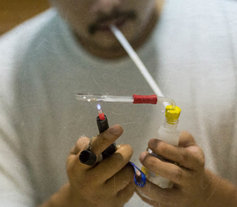A Family Guide to Stopping Meth Abuse

Methamphetamine is, without a doubt, one of the most addictive and dangerous drugs available. It does not even carry with it a veneer of being glamorous or cool, so devastating are the effects of using it. You would have a hard time finding a person who had been using methamphetamine for any period of time and yet who was able to keep up appearances or remain a functioning addict, someone who can still operate in the day-to-day world without letting the consequences of drug use cause obvious effects.
If you have a family member who is using meth, you most certainly know that something is going wrong, even when you have not yet confirmed the fact that meth is the problem. Meth addiction can quickly take over a person’s life, causing things to get out of control and tearing apart the family of the addict. It is absolutely vital that you take action to handle the situation if a member of your own family is using meth, and you must do what you can to prevent the problem from developing into a full-blown addiction, to get the person into treatment if he or she has already crossed that line.
Education About How Meth Works
The first step you should take in attempting to intervene in a loved one’s meth problem is to make sure that he or she understands how the drug works, what makes it addictive and why it is dangerous. Knowing this, it is easier for a person to recognize what the drug is doing to his or her body and why it is time to quit.
Essentially, methamphetamine has such powerful effects because it manipulates an action in the brain in two ways, whereas most drugs affect that same action in only one route. Meth causes the brain to release dopamine, a chemical which is associated with feelings of pleasure, reward or euphoria. Many drugs have this effect, but methamphetamine goes further and inhibits the reuptake of dopamine, with the result that the brain is bathed in dopamine, a result shared with using certain other types of drugs. This may feel great at first, but with repeated use, the person will suffer from depletion of dopamine, and the brain will adapt to these unnatural highs and will become dependent on the drug for even normal levels of dopamine. The power of the grip that this addiction holds on the person is so great that it can compel him or her to do previously unimaginable things, and it is not uncommon to find meth addicts living in squalor, resorting to crime and debasing themselves utterly just to get the next fix. Furthermore, using meth can cause an extreme deterioration in physical health, as can be witnessed in the Faces of Meth series, showing mugshots of people at progressive stages of addiction to methamphetamine.
Help for Meth Addiction
If you have been fortunate enough to catch the problem before your family member has become fully addicted to meth, you may be able to turn the situation around at this point. By appealing to his or her sense of reason and sharing the facts about the drug, you might be able to get the person to make the decision to quit and that will be it. But there is a good chance that you will be too late for this, since methamphetamine is such an addictive drug that a large percentage of those who begin using it even casually do get hooked quickly.
In this case, you need to do whatever you can to get your family member into rehab. Don’t count on an out-patient program to work—there simply isn’t enough control of the situation in such a scenario to ensure that the person stays clean long enough. You should not expect the results you need from a 28-day rehab, either, since such programs often send people back out into the world before they have fully recovered and only set the person up for the crushing defeat of a relapse. An inpatient drug rehab program that does not graduate individuals until they have fully achieved the results of stable sobriety is the answer to meth addiction. Withdrawing from methamphetamine requires careful supervision and an environment where the person will be safe and free from any chance to get another fix.
Once this is done, he or she must be able to thoroughly detoxify from the long-term effects of using the drug, and must additionally take steps to address the underlying issues which caused him or her to use drugs in the first place, as well as working to rebuild his or her life and repair the damage done by using meth.

Narconon provides this type of solution, and countless thousands of people have over the years recovered from addiction to meth and other drugs at Narconon centers across the United States and worldwide. If a member of your family is struggling with addiction to meth, contact Narconon now for help from someone who can guide you on your next steps to get your loved one into treatment.
 ®
®